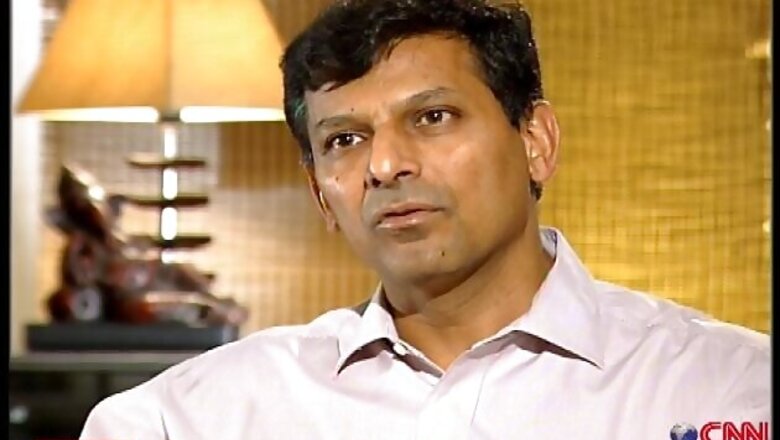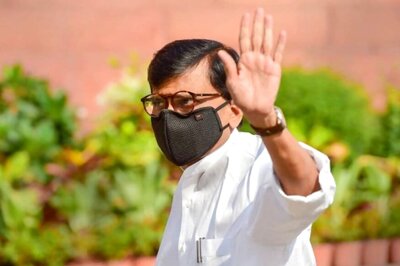
views
Mumbai: Reserve Bank of India governor Raghuram Rajan said he was not worried about rupee overvaluation for now. Strong foreign fund inflows over the last couple of months have lifted the rupee to an 8-month high, stoking concerns that India's exports could become uncompetitive. "When we were at 60/$, people said 75-80/$ and now we are back at 60/$, they are saying 55-50/$ and I heard some 45/$ also," Rajan said in an exclusive interview to CNBC-TV18's Latha Venkatesh.
"There are levels at which you believe that this is a recipe for increased volatility in the future and we would try and avoid reaching those levels. I think that a certain amount of leeway this way that way is fine; we are not overly worried about that," Rajan said. India's exports have slowed down in the last three months even as trade deficit has been narrowed. But Rajan rejected a link between slowing exports and a strengthening rupee, saying it had more to do with the sluggish growth in developed countries in the first quarter of this calendar. He sees the trend persisting for a while.
However, he said India's export sector could be hurt if the rupee strengthened to 50-45 to the dollar, especially since the currencies of competing emerging market economies were weaker. On inflation, Rajan said it was not a given that inflation would only rise in the months ahead. He said a good Budget by the new government and stable crude oil prices could help keep inflation in check. "You can also see that disinflation is not just food disinflation; you are seeing some slowdown in services," he said.
Rajan said there was encouraging signs of inflation coming under control, but would wait for further confirmation. "I do not want to declare victory; we are far from it right now, there is a long haul ahead but these are encouraging signs that things are biting and let us see how it goes," he said. In its monetary policy on April 1, the RBI had warned of risks to its consumer price inflation target of 8 percent, due to likely weak monsoons, uncertainty over subsidy prices, fiscal policy and geo-political developments.
"What I think I can say is at this point we have set rates appropriate to hit the 8 percent and of course if we see a substantial movement in either direction, we will have to rethink our stance," Rajan said. In the last two years, the RBI has been criticized for its policy to keep interest rates high even as the economy was sliding downhill. While being non-committal on the likely interest rate trajectory, Rajan nevertheless hinted that chances of more rate hikes appeared slim.
"We are not trying to accelerate the process of disinflation through cranking up the interest rate machine as high as possible but we think that over this time we can do it with reasonable interest rates. So, let us see and certainly if we think that there is room that has built up because we can achieve it with even lower interest rates, we will be happy to cut, but we have to make a judgement as and when the time comes," he said. On the issue of bank licences, Rajan said those would be issued once the Central Committee board took a decision. The Election Commission on Tuesday gave permission to the RBI to issue new bank licences.
Here is an excerpt from Raghuram Rajan interview to CNBC-TV18's Latha Venkatesh:
Latha Venkatesh: Starting with the monetary policy that was just announced - you have indicated that risks to inflation are on the upside. Is there anything at all that is giving you confidence that this beast is coming under control, anything in terms of rural wages or minimum support prices (MSP) trends, which gives hope?
Raghuram Rajan: It is two sided risks. I do not want to say that risks are only to the upside, for example if we get a better budget than is expected then it would create a lot of confidence, it would give us some room to make some adjustments, for example on statutory liquidity ratio (SLR) which I said yesterday. Oil prices - Brent today is at USD 105 per bbl, some stability on oil price even reduction would help tremendously. There are number of risks that could go either way. That said, you can also see that disinflation is not just food disinflation; you are seeing some slowdown in services. Yesterday's consumer price index (CPI) industrial worker came in, which was quite encouraging at around 6.7 percent. These are signs that something is taking effect.
Now I do not want to declare victory; we are far from it right now, there is a long haul ahead, but these are encouraging signs that things are biting and let us see how it goes. I also believe that we need moderation in the support prices for agricultural commodities and there has been moderation last year. Let us see this year. I do not see tremendous increases - that could also help. Things are coming together and that gives me some hope that we will get traction.
Latha Venkatesh: Yesterday's policy was full of red flags in the sense you pointed out milk prices and CPI services not showing a fall, chances of even the output gap having narrowed and today the bond markets are indicating that there might be an extended pause from RBI. As one person put it - 50 percent chance of an extended pause, 30 percent chance of a rate hike in the next one year and 20 percent chance of possibly a rate cut, is that fair assessments of the situation as you see it?
Raghuram Rajan: What I think I can say is at this point we have set rates appropriate to hit the 8 percent. If we see a substantial movement in either direction, we will have to rethink our stance. What is important to focus on is that once inflation comes down; there will be substantial benefits to the economy both from the increased savings, which will help create more capital for industry as well as this uncertainty about the future path of interest rates will be diminished and all this will be helpful. Let us not focus primarily on what the level of rates will be,, but focus on all the collateral benefits also that once inflation starts coming down. So, let us wait and see.
Latha Venkatesh: There is an interpretation by some economist after you gave your glide path of 6 percent by 2016 that you will not be able to move on rates or you may not move on rates till you are within striking distance of 6 percent because if you did start lowering if the economy were at 7.5-7 percent inflation you may push it back to 8 percent. So, probably your pause will extent till 6 percent?
Raghuram Rajan: The idea is that glide means glide that we wanted to move in one direction while willing to overlook transient movements in the inflation rate - things that we do not think are likely to persist. Also, monetary policy generally is aimed at being stable and predictable rather than reacting to every little change. The point about saying 8 percent and 6 percent was to say that we will be happy if we reach those levels over the period. We are not trying to accelerate the process of disinflation through cranking up the interest rate machine as high as possible, but we think that over this time we can do it with reasonable interest rates. So, let us see. Certainly, if we think that there is room that has buildup because we can achieve it with even lower interest rates, we will be happy to cut, but we have to make a judgement as and when the time comes.




















Comments
0 comment